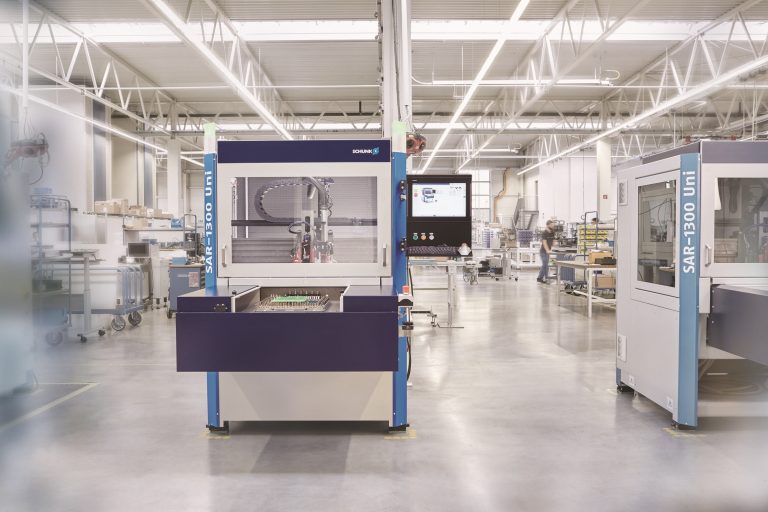From 18 to 21 November 2025, the electronics industry will gather at productronica in Munich. One of this year’s three key themes will be secure and trustworthy microelectronics. As global threat levels continue to rise, sensitive information requires ever-stronger protection. This trend directly benefits the industry, which is driving innovation with new microelectronic solutions for the technologies of tomorrow. The conceptual and technical sponsor of the trade fair is the VDMA Productronic Association.
Electronic components and systems must be designed, manufactured and operated in a way that ensures reliable, secure and tamper-free performance, while maintaining full compliance with specifications throughout their entire lifecycle. In critical infrastructures such as medical technology, transportation, energy supply or telecommunications, secure and tamper-proof components are just as essential as they are for mechanical engineering users. Trustworthy microelectronics ranges from secure microcontrollers (MCUs) and transparent supply chains to “security by design.” New requirements are emerging from legislation including the Cyber Resilience Act and the Trusted Foundry Program.
Secure Electronic Components and Transparent Supply Chains More Important Than Ever
According to a study by Custom Market Insights, the global market for secure microcontrollers is set to grow from USD 27.6 billion in 2025 to an estimated USD 80.7 billion by 2034 — a compound annual growth rate of 12.5 percent. A key growth driver is the defence sector. As Research and Markets reports, demand for trustworthy microelectronics is rising sharply due to increasing global conflict.
So-called military-grade components must withstand extreme environmental conditions such as high temperatures or radiation and incorporate numerous security-driven design features.
The importance governments place on trustworthy electronic components is illustrated by the United States: According to Reuters, the U.S. government granted Intel up to USD 3 billion in funding in 2024 to develop a “secure enclave” and establish trusted manufacturing for chips used in security-critical applications.
Protecting IP Begins at the Design Stage
Unlike software, hardware is difficult to protect from unauthorised access: once manufactured, redesigns are either impossible or extremely costly. For this reason, open architectures such as RISC-V are increasingly adopted. For example, Fraunhofer IZM’s “AIRISC” family provides efficient hardware for sensor applications and embedded AI, with a strong focus on safeguarding the embedded IP.
“Security-by-design” tackles the issue early in the development cycle. State-of-the-art SAFE-SiP processors (Secure Authentication Framework for System-in-Package) integrate components from different manufacturers, increasing complexity and significantly reducing the attack surface. The development of “secure enclaves” follows the same principle: highly sensitive areas within a processor — where confidential data and computations are processed — are isolated from the rest of the hardware and software.
With regard to supply chain security, the biggest challenge lies in establishing trust across multiple manufacturers and production steps — particularly in logistics and testing processes, as the Research Fab Microelectronics Germany reports. Strengthening supply-chain security is a key objective of initiatives such as the EU Chips Act, the IPCEI programme (Important Project of Common European Interest) and the U.S. Trusted Foundry Program.
Exhibitors Showcase the Latest Innovations
Visitors to productronica in Munich will be able to explore the latest innovations in trustworthy microelectronics firsthand. PhoenixD, for instance, will present a micro-optical system made of glass substrate at the VDMA Special Exhibit area (Hall B2, Stand 461), enabling tap-proof telecommunications. Segger Microcontroller will showcase a range of solutions for embedded system security — including firmware protection, IP safeguarding and secure programming and development tools such as “J-Link” debug probes and software security libraries like “emSecure” and “emSSL.”
Bosch Manufacturing Solutions (BMG) will present solutions for secure and reliable industrial production environments — a vital foundation for trustworthy microelectronics at the manufacturing level. BMG supports companies with encrypted and secured data communication, real-time transparency and monitoring, as well as remotely maintainable systems with strict access protection.
A key attraction will be the VDMA co-exhibitor “Chipdesign Germany,” offering visitors an inside look at the German chip development ecosystem. The stand provides a compact, hands-on introduction to the design process of digital integrated circuits — from concept and design through to finished hardware. Exhibits such as wafers, masks and chips illustrate each step and can be examined under a digital microscope.
The supporting programme at productronica will also address trustworthy microelectronics, including forum discussions. On Wednesday, 19 November, the Innovation Forum will host a panel titled “Microelectronics for Safety-Critical Technologies – What Measures Are Needed for Secure Supply Chains?”
productronica: “the pulse of innovation”
In November 2025, the world’s leading trade fair for electronics development and manufacturing will once again bring more than 1,400 exhibitors to Munich under the motto “the pulse of innovation.” Attendees can explore AIRISC, SAFE-SiP and other technologies directly at exhibitors’ stands. Extensive supporting events — including panel discussions, expert presentations and networking formats — provide additional insights. In Halls B1, C1 and C2, SEMICON Europa will offer a close-up view of the entire value chain of the semiconductor industry.
< Back to Electronics, Components
> Here is one of the places where the issuer of a news item is branded.
> Tap buttons or logos to be redirected to the issuers profiles or pages.






